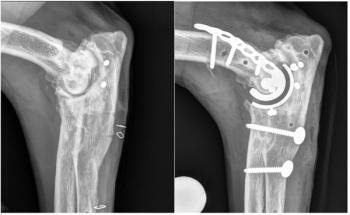
To glasgow and beyond: Appreciating, adapting, and applying pain scoring systems (Proceedings)
The 4th vital sign: pain.
The 4th vital sign: pain. There are a myriad of negative consequences associated with inappropriately managed pain: decreased healing, infection, heightened reactions to pain, changes to the CNS. Utilizing pain scoring systems reduce pain states and improve patient care.
Poorly managed pain, whether before, during, or after anesthesia, can have a number of harmful consequences. Most publications on the subject of pain management in both “traditional” canine/feline patients and “non-traditional” exotic patients show appropriate analgesia and pain management to be essential to wound healing and patient recovery. Improperly managed pain affects the patient and the owner.
Pain is an individual experience and can be somewhat subjective; many factors can affect how pain is interpreted. In humans and animals alike pain is tolerated differently. It can be influenced by genetics (think husky dog versus Staffordshire terrier), learned behaviors, and even culture. In veterinary patients the challenge of adequately recognizing, assessing, and treating pain is further complicated by the non-verbal nature of the patients. Much of the pain assessment techniques used in animals is modeled after what is used in human medicine for infants, toddlers, and other non-verbal patients. In the AAHA pain management guide for cats and dogs it is stated, “It is now well established that animals and humans have similar neural pathways for the development, conduction, and modulation of pain. According to the principle of analogy, because cats and dogs have neural pathways and neurotransmitters that are similar, if not identical, to those of humans, it is highly likely that animals experience pain similarly.” Read this to mean if it would cause discomfort to you, it would cause discomfort to your patient, regardless of species.
To better understand how to manage pain, one should have a fluency in the “language” of pain:
- Pain: an unpleasant sensory and emotional experience associated with actual or potential tissue damage; the perception of nociception
- Nociception: the activity produced in the nervous system by noxious stimuli
- Analgesia: absence of pain in response to normally painful stimuli
- Hyperalgesia: an increased response to a normally painful stimulus
- Allodynia: pain due to a stimulus that does not normally produce pain (i.e. touch)
- Central Sensitization: “Wind up pain;” changes in the central nervous system that occur as a result of repeated or chronic painful stimulus
- Analgesic: an agent or drug that causes or allows for relief from pain; a “pain killer”
The pain pathway in the body can be broken down into four basic groups: transduction, transmission, modulation, and perception. Analgesics and analgesic techniques work to modify to pain felt and transmitted throughout the circuit. Different analgesic drugs work on different parts of the pathway.
- Transduction: change of cellular chemical information into electrical impulses that travel the spinal cord
- Transmission: travel of the pain impulse; transmitting the signal to the brain
- Perception: cognizant recognition of painful stimulus
- Modulation: Brain and spinal cord communicate and work together to change or modify the painful sensation
There are typically describe 6 types of pain:
- Somatic Pain: at the level of the skin; also involves muscles, tendons, and joints
- Visceral Pain: Internal organs, soft tissue
- Acute Pain: Recently occurring, generally less than a few months
- Chronic Pain: Longer in scope, lasting more than a few months
- Neuropathic Pain: Atypical pain, ie: phantom limb pain
- Referred Pain: Pain perceived in a region disparate from the actual painful site
Pain perception can be broken down into 3 sections: Perception (recognition of discomfort), Threshold (point when painful signal hits the brain), and Tolerance (amount of pain that can be endured). In order to assess pain thoroughly, consider these categories: Incidence, Level, Location, Length. For each patient, each category can have varying levels of intensity. All veterinary patients will be non-verbal, so the difficult task is to use behavioral assessments to answer questions of how painful an animal is. There are species differences in pain behavior, but many pain mannerisms are universal.
Universal non-verbal pain indicators
- Abnormal posture
- Restlessness
- Splinting
- Vocalizing
- Unwillingness to move
- Trembling/shivering
- Anorexia
- Elevated physiologic parameters
- Aggression (towards self or others)
- Lack of grooming
- Self-mutilation
Pain is often characterized and describe as it is relevant to the owner. An adequate and thorough “pain history” can be very useful when creating an appropriate analgesic plan. The history should include:
- Previous/ongoing painful states
- Previous methods of controlling pain
- Owner's expectations for pain control
- How/why the owner feels a patient is painful
The “FLACC” scale is often used in human medicine for non-verbal patients (infants, toddlers, demented patients, critically ill/unconscious patients) and has applications for veterinary patients. FLACC stands for “Face” (relaxed/grimace/tightened face), “Legs” (normal posture/kicking/restless), “Activity” (normal/restless/agitated), “Cry” (quiet/whimpering/frequent complaints), and “Consolability” (content/distractable/unable to comfort). Each area is ranked 0-2, with elevated numbers requiring treatments.
In veterinary medicine, there are 3 primary scales that have been adapted and utilized for pain assessment.
CSU acute pain scales
Colorado State University created pain scales for canine and feline patients, based on behavior and physical reactions to stimuli. It is an exceptionally easy to use scale, but does not necessarily have clinical validation to support it. It does have forms for both canine and feline patients.
Glasgow composite measure pain score-short form
This form is based on specific behavioral markers, assigning numeric points to determine level of pain. This scale is used universally, everywhere from small private practices to veterinary teaching institutes. This scale is designed for canine patients. This scale does have some clinical research to support it.
UNESP-botucatu multidimensional composite pain scale
This form is the feline companion to the Glasgow Pain Scale. It utilizing 10 categories to assign numbers for painful behaviors.
Using a behavioral checklist is likely the most common way to create a pain assessment chart. Having a chart on hand allows for a standard, equal, reproducible way to evaluate pain in patients.
Behavior based charts should include categories for:
- Attitude or Mentation
- Activity
- Facial expression
- Guarding
- Posture
- Vocalization
Above all, treat each patient as an individual. If pain is suspected, treat. If an animal responds to analgesic intervention, that too is considered a point on the pain assessment scale.
References always available upon request.
Newsletter
From exam room tips to practice management insights, get trusted veterinary news delivered straight to your inbox—subscribe to dvm360.






